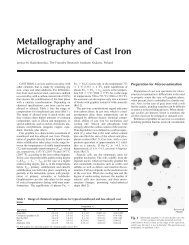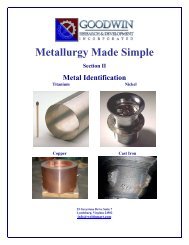Introduction Quantitative X-Ray Diffraction Methods Introduction ...
Introduction Quantitative X-Ray Diffraction Methods Introduction ...
Introduction Quantitative X-Ray Diffraction Methods Introduction ...
You also want an ePaper? Increase the reach of your titles
YUMPU automatically turns print PDFs into web optimized ePapers that Google loves.
<strong>Introduction</strong> <strong>Quantitative</strong> X-<strong>Ray</strong> <strong>Diffraction</strong> <strong>Methods</strong><br />
(prepared by James R. Connolly, for EPS400-001, <strong>Introduction</strong> to X-<strong>Ray</strong> Powder <strong>Diffraction</strong>, Spring 2010)<br />
Free Software for <strong>Quantitative</strong> Analysis:<br />
GSAS – General Structural Analysis System is a very mature Rietveld program, and comes<br />
in versions to run on Windows/DOS PCs and Linux systems. It has been developed<br />
as free open-source software and is maintained and distributed by Allen C. Larson &<br />
Robert B. Von Dreele of Los Alamos National Laboratory. It comes with a 231 page<br />
manual which contains surprisingly little about Rietveld refinements and is chiefly<br />
concerned with how to interact with the 37 different program modules. Written<br />
originally for UNIX, the “port” to the Windows platform makes extensive use of<br />
Command (i.e., DOS) Windows and behaves much like a bunch of Terminal<br />
windows. Initial impressions are quite intimidating, but the software gets great<br />
reviews from those who learn to put it through its paces. All versions are available<br />
via FTP from ftp://ftp.lanl.gov/public/gsas. We have a recent version available on<br />
our FTP site at ftp://eps.unm.edu/pub/xrd/index.htm.<br />
FullProf – Another widely used Rietveld system produced by Juan Rodríguez-Carvajal at the<br />
Laboratoire Léon Brillouin (CEA-CNRS) in France. Though it has a somewhat<br />
friendlier GUI interface than GSAS but is still a complicated analytical tool requiring<br />
good data input by a user who understands diffraction data, and crystal structure<br />
analysis, and is willing to master fairly complicated input data file structures. The<br />
139-page FullProf 2000 manual (in Acrobat PDF format) includes a good discussion<br />
of the Rietveld procedure and suggests the best sequence of steps to follow to produce<br />
a good refinement. We have a recent version of FullProf on our ftp site at at<br />
ftp://eps.unm.edu/pub/xrd/index.htm. The CCP14 source page for FullProf with<br />
tutorial information and links is at<br />
http://www.ccp14.ac.uk/tutorial/fullprof/index.html.<br />
FULLPAT – Dave Bish and Steve Chipera's Excel-spreadsheet-based whole pattern fitting<br />
system uses the Excel solver functions to do a least squares refinement to fit wholepattern<br />
data to standard pattern data to produce quantitative analyses. The program<br />
archive consists of two files -- the actual Excel spreadsheet used to do the calculations<br />
and a well written 23 page manual that explains the use of the program in sufficient<br />
detail to make it usable. It does require rather extensive development of in-house<br />
standard XRD patterns prepared using a suitable corundum standard as a "spike".<br />
This system was used routinely in Bish and Chipera's well respected LANL XRD lab.<br />
Available from CCP14 (http://www.ccp14.ac.uk/ccp/web-mirrors/fullpat/) or on our<br />
FTP site at ftp://eps.unm.edu/pub/xrd/index.htm.<br />
RockJock – Uses Microsoft Excel Macros and the Solver function to perform a whole-pattern<br />
modified Rietveld-type refinement to perform quantitative analysis. Written by<br />
Dennis D. Eberl, the software was published in 2003 as U.S.G.S. Open-File Report<br />
03-78, “Determining <strong>Quantitative</strong> Mineralogy from Powder X-ray Diffration Data”.<br />
RockJock requires careful sample preparation, good machine characterization and the<br />
use of a ZnO internal standard for best results. It is widely used in clay analyses.<br />
Available via FTP from ftp://brrcrftp.cr.usgs.gov/pub/ddeberl/RockJock.<br />
(Material in this document is borrowed from many sources; all original material is ©2010 by James R. Connolly)<br />
(Revision date: 6-Apr-10) Page 14 of 14








